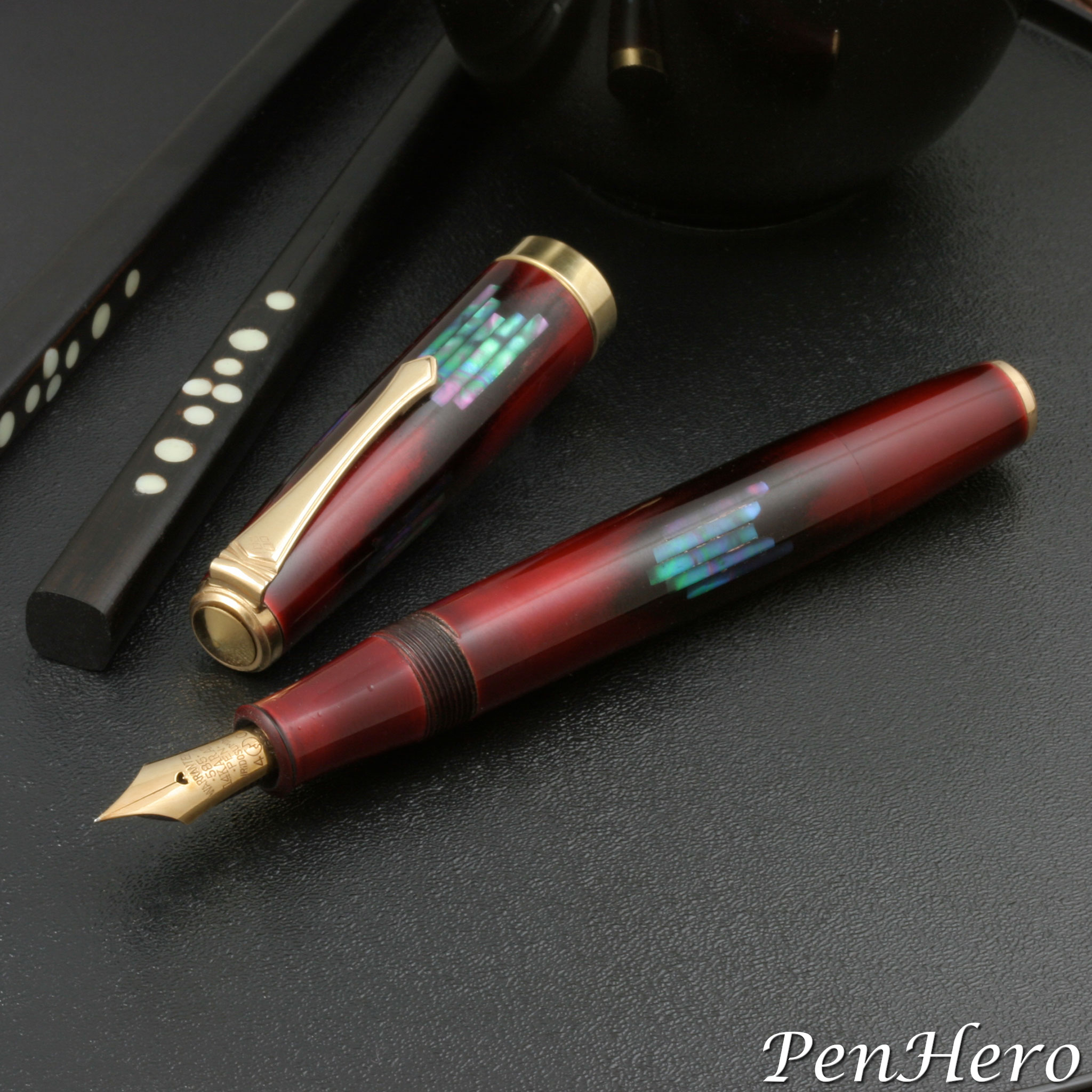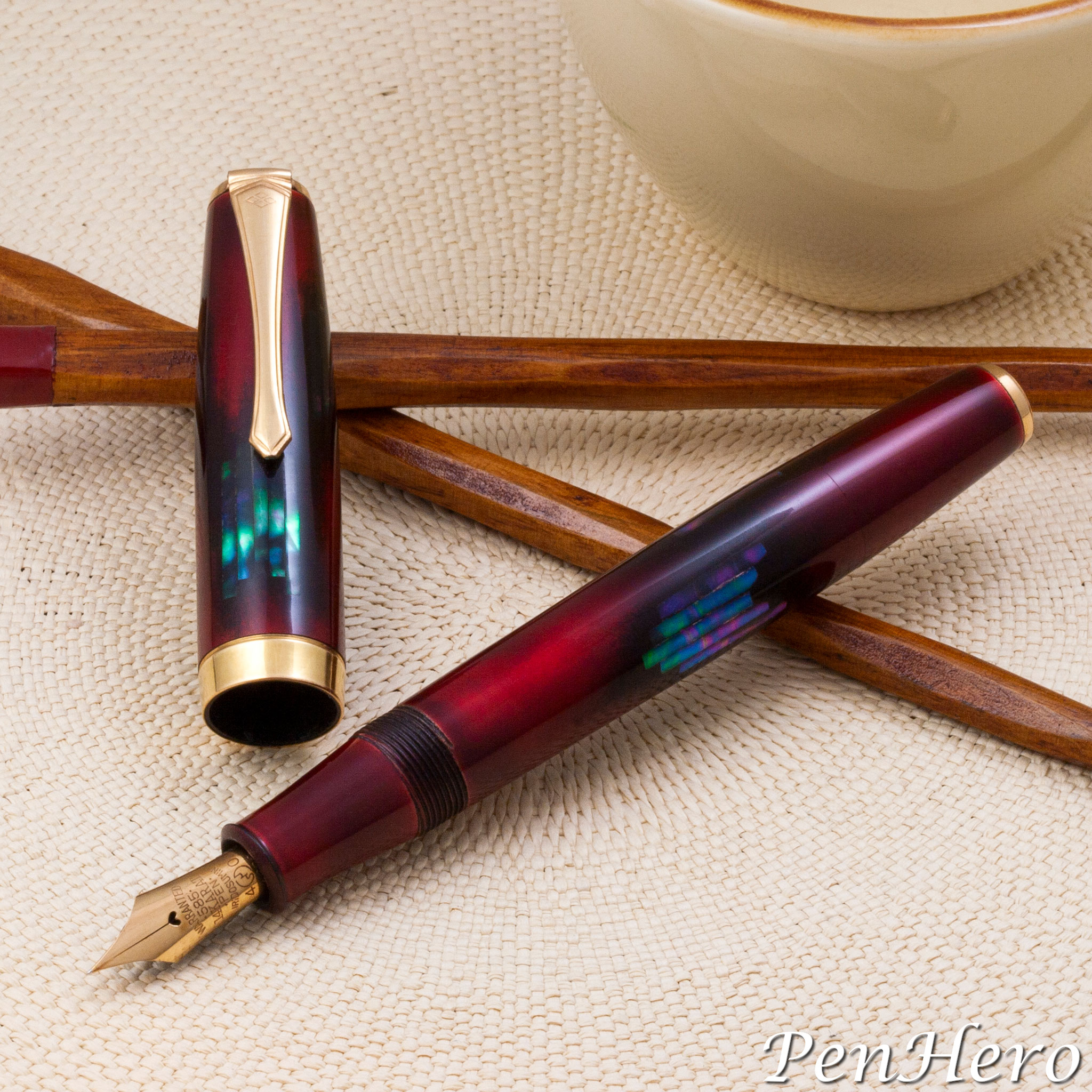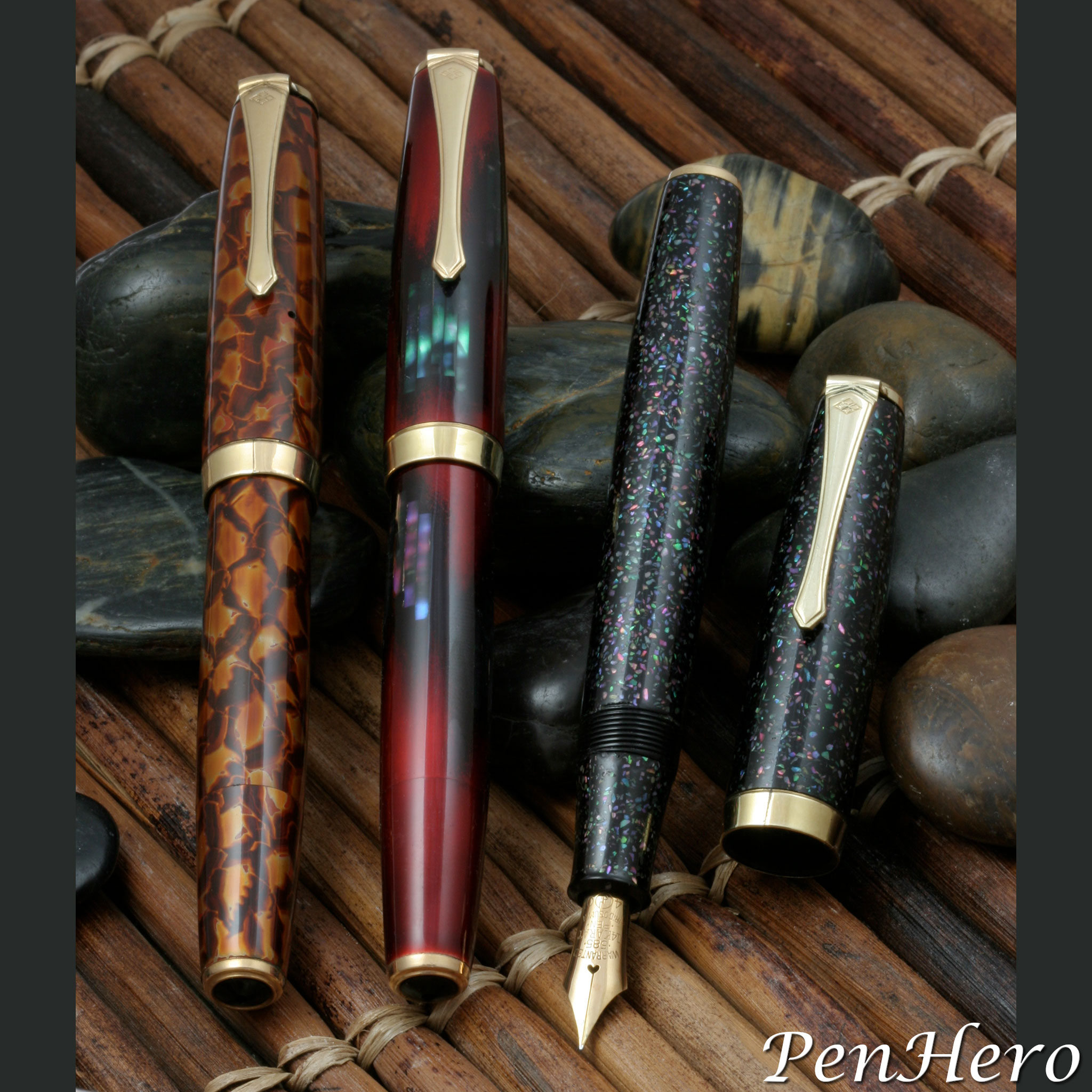Yotubishi Raden Tanzaku Decorated Pen c. 1957
by Jim Mamoulides, May 24, 2024
 Yotubishi Raden tanzaku decorated pen c. 1957
Yotubishi Raden tanzaku decorated pen c. 1957
Like Shimmering Stained Glass Panels
This is a c. 1957 Yotsubishi ink shut-off eyedropper fountain pen decorated using a tanzaku style Raden mother-of-pearl shell inlay technique on red urushi lacquer done in two panels, one on the cap and one on the barrel. The pen was featured in the winter 2006 Pennant article “Collecting Japanese Pens” by Stan Klemanowicz. It was made by Ishi-Shoten Yotsubishi (literally yotu = four, bisi = diamond), a company from Osaka that made highly collectible decorated pens, but according to the article, sourced nibs and hardware from other pen companies. The four diamond logo can be seen at the top of the clip. The nib on this example is stamped WARRANTED over 585 over 14 KARAT over PEN over IRIDOSUMIN over the JIS mark flanked by 4 and 0. A similar c. 1958 lever-fill pen with more Raden inlay panels by artist TouUn is shown on page 117 of Fountain Pens of Japan.
The Japan Industrial Standard (JIS) marking for fountain pen nibs was instituted in 1951 and gold nibs intended for export were required to have the JIS mark in 1952. Gold nibs intended for domestic sale were required to have the JIS mark in 1953. Nibs are stamped with the JIS mark and a four digit number indicating the maker. The JIS nib number on this nib is difficult to read because it is set deeply in the section. I could not pull the nib out to check it, but it appears to be 4622. That number would be for Kabutogi-Seisaksho Tabata by Ginjiro Kabutogi, who had the brand Seilon, according to the list of JIS numbers in Fountain Pens of Japan.
An eyedropper pen with an ink shut-off valve at the end of the barrel, it fills like any other eyedropper type, by first unscrewing the nib section from the barrel and then dripping ink into the barrel using a bulb eyedropper. The knob at the end of the barrel, seen by the faint seam near the bottom, is attached to a long rod that extends inside the barrel up to the base of the feed in the nib section. When the knob is screwed flush with the end of the barrel, the rod cuts off ink flow to the feed, becoming an ink shut off valve, making the pen safe to pocket or put down. To write, the knob must be unscrewed slightly, pulling the stopper back from the base of the feed, which allows ink to flow to the nib.
Raden Tanzaku Decoration
Raden is a technique that uses natural mother-of-pearl material where the artist cuts small flat pieces and pastes them onto the surface of the object. In some objects the shell material is inlaid into the surface. According to Fountain Pens of Japan, ra means “conch shell” and den means “studded material.” The artist will use different mother-of-pearl materials to create mulitple color effects in the artwork. Tanzaku, originally meaning "strips of paper", is a type of Raden technique where the shell material is cut into thin rectangles and then inlaid or overlaid, often to create repeating patterns.
 Yotubishi Raden tanzaku decorated pen c. 1957
Yotubishi Raden tanzaku decorated pen c. 1957
To create the artwork for this pen, the cap, barrel and nib section are first coated with urushi lacquer. Then the artist made rectangular mother of pearl inlays and glued them to the cutouts in the cap and barrel surface creating a wave pattern decoration. The mother-of-pearl inlay pieces were carefully chosen to create a panel of five strips with an effect like a stained glass window with colors including pink, purple, green, blue, fuscia, and white showing through. The edges around the inlays were darkened, feathering out into the red urushi lacquer covering the rest of the cap and barrel.
The technique gets its name tanzaku (短冊) from the long strips of paper used to write poems, create small paintings, and wishes for the Japanese Star Festival, Tanabata. The festival celebrates the annual meeting of the lover deities Orihime and Hikoboshi, who are kept apart by the Milky Way, and only being allowed to meet once a year on the seventh day of the seventh month on the traditional lunar calendar. The lovers are represented by the stars Altair and Vega. Looking into the night sky, Altair and Vega appear on opposite sides of the Milky Way, as if separating Orihime and Hikoboshi. Part of the festival celebration is writing wishes on small strips of colored paper, tanzaku, and hanging these wishes on bamboo tree branches. The festival was brought to Japan from China in the feudal period.
Yotubishi = Four Diamonds
Ishi-Shoten, also known as Ishi & Co., was established in Tokyo in 1925 by pen maker Yoshinosuke Ishii. Following the lead of Pilot, who began making maki-e pens in the 1920s, Ishi-Shoten, though a small company with initially as few as ten workers, began competing by making less expensive maki-e pens. Ishi-Shoten used the four diamond trademark, yotsubishi in Japanese, and the mark can be found on the clip top on most pens, and sometimes on the cap band. In reference materials, on the pens, and in catalogs, there are three spellings, Yotsubishi, Yotubisi, and Yotubishi, all pronounced the same. Fountain Pens of Japan makes the distinction that the company name became Ishi-Shoten Yotsubishi, but the brand name was Yotubishi. The company ceased operations in 1984.
 Yotubishi Raden tanzaku decorated pen c. 1957 (center)with Yotubishi free pattern maki-e decorated pen (left) and Yotubishi Raden decorated pen (right)
Yotubishi Raden tanzaku decorated pen c. 1957 (center)with Yotubishi free pattern maki-e decorated pen (left) and Yotubishi Raden decorated pen (right)
This is another very beautiful and very well made pen by Ishi-Shoten Yotsubishi. The Raden tanzaku mother-of-pearl artwork patterns are like stained glass windows with a dark surround set into a deep red wall. The variety of colors and the choice to set each rectangular piece makes each of the five strip inlays appear as a shimmering defocused view into a colorful outside world. The pen was not filled or dipped, as it was on loan for photos, but the nib feels very smooth from dry write testing.
Another exceptional pen from Ishi-Shoten showing the collectability of Yotsubishi art pens made in the 1950s. They are very uncommon in the United States and this one would be a prized pen in any collection.
References
“Collecting Japanese Pens” by Stan Klemanowicz, The Pennant, Winter 2006, published by the Pen Collectors of America
Fountain Pens of Japan by Andreas Lambrou and Masamichi Sunami, © 2012 Andreas Lambrou Publishers, Epping, Essex, United Kingdom, pages 28, 101-118
"Tanabata", Ministry of Foreign Affairs of Japan, © 2023 Web Japan
“Tanabata (Star Festival)”, nippon.com, © 2011-2024 Nippon Communications Foundation
Interact
Comments on this article may be sent to the author, Jim Mamoulides


